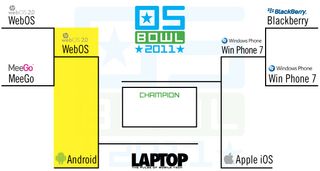OS Bowl Game 3: Android vs. webOS. Voting ends 2/2 at 9 a.m.

After trouncing MeeGo in the first round, webOS now takes on a tougher challenger: Google's Android OS.
In two short years, Android has risen to become the best-selling mobile OS in the world. And with good reason: Android is highly customizable, available on a wide variety of smart phones (there's a phone for every personality), and has the tightest integration with Google's ubiquitous services, from email and maps to instant messaging. The Android Market also continues to grow, stocking 200,000+ apps.
Android 2.3 (Gingerbread) adds some polish in the form of interface tweaks, as well as improved copy and paste and support for Near Field Communications. An NFC chip, such as the one inside the Samsung Nexus S, will enable users to learn more about businesses just by tapping a sticker. This technology could also eventually allow Android phone owners to pay for real-world goods with a tap. Moreover, Google is working on an in-app payment system, eliminating one of the OS' few remaining pain points.
Android 3.0, a.k.a. Honeycomb, will feature a new interface optimized for tablets. You'll get bigger, more interactive widgets, tabbed browsing, improved multitasking, and more. You can learn more about this OS right here.
As we said in the first round, webOS is in a bit of limbo (until Feb. 9th, at least) but the current version, webOS 2.0 adds even more goodies, such as grouping open apps together in stacks and the ability to start an e-mail, update your status and more by just typing. Plus, a new Exhibition feature promises to let you do more with HP’s clever Touchstone Charging Dock, such as displaying a Facebook slideshow when you set your phone down. Based on what we've heard HP-Palm's OS will scale quite nicely to larger screen tablets.
So, which OS do you think is better?
[polldaddy poll="4463647"]
Stay in the know with Laptop Mag
Get our in-depth reviews, helpful tips, great deals, and the biggest news stories delivered to your inbox.
